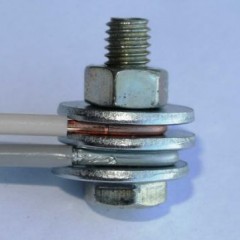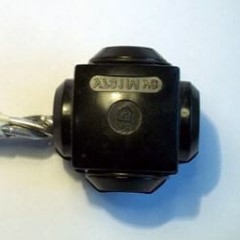Connection of wires with PPE caps
Cap design
The design of the device includes such components: cap and steel spring. The PPE cap is made of plastic, which has electrical insulating properties. Such plastic is non-combustible and resistant to high temperatures, and is also able to withstand a voltage of 600 volts. These indicators are usually prescribed on the packaging.
As for the spring, it is made of steel in the form of a cone and with the help of turns compresses the wire more strongly. The steel spring is additionally treated with an electrochemical protective layer. The dimensions of the spring should be equal to the area of the smallest part of the housing, where the wire will be in maximum contact with another conductor. Therefore, it is extremely important to choose the exact dimensions so that the connection is as correct and reliable as possible.
It is worth noting that PPE caps are of two types - with ears and without ears. There are no special differences, but caps with ears are easier to wind on a wire, and without ears they take up less space in the distribution box.
Application rules
There are two methods of twisting with the help of PPE caps: without preliminary twisting of cores and with it. If it is necessary to connect two conductors, then they can be conveniently inserted into the spring by applying a certain force, and twisting is carried out using rotational movements (clockwise). If there are three or more conductors, then here you must first twist them together using pliers. After that, bite off the uneven ends and, using force and rotating movements, install them in the PPE, as shown in the photo:
It is important to remember that for full contact contact, winding should be done clockwise, not vice versa. And do not forget about the use of force, so that the coils of the spring can easily move apart, and then squeeze the wire well.
The plastic housing insulates the place where the connection was made and thereby mechanically protects the cores. The insulation should be removed from the conductor so that the exposed part does not extend beyond the cap, but at the same time goes under the spring as much as possible. If everything is done correctly, then additional insulation is not needed.
When screwing the PPE into a twist, the spring moves apart and compresses the wire. Such a connection will proceed correctly if the correct cap corresponding to its rating is selected. If you select the device incorrectly or inadequately install it, this can lead to bad consequences. Therefore, it is extremely important to choose the right category.
The video below clearly shows how to use the connecting insulating clamps:
Connector Labeling
How to choose a cap? After all, the sizes and cross-sections of twisting are different and are classified by the total cross-sectional area of the veins. This area is indicated in the connector number, which can be from one to five. The larger the number, the more wires the cap is able to connect.
But with such numbers you need to be careful, as there are two types of devices: domestic and European. Both standards have the same designation - numbers, only European ratings are much smaller than domestic ones. Therefore, when buying PPE, it is better to pay attention to the total cross-section than to its number. All this is written on the packaging.
Product marking is carried out as follows: first, the abbreviation PPE is prescribed, then the type of housing (with or without protrusions) is marked. The protrusion is necessary for better fixation by the fingers of the clamp. After the type of housing, the total cross section of the wires that are connected in the clamp is registered. The cross section varies from 0.5 to 10 mm2. As a rule, depending on the type and size of the product, their bodies are painted in a certain color, so that it is convenient to use caps. The table below indicates the color scheme depending on the type of case, so you will understand how to choose a PPE for twisting:
It should also be remembered that caps can only be used when two identical wires are connected. If you want to connect aluminum and copper wires, then to do this with the help of PPE is already impossible. In this case, you can apply terminal block, metal clip (nut) or bolt.
Advantages and disadvantages
Such a connector is convenient and practical, therefore, it has the following advantages:
- Affordable price.
- Probability auto ignition electrical wiring missing. This is due to the fact that non-combustible material is used for the manufacture of PPE, and self-ignition is not possible where twisting was performed.
- Quick and easy product installation.
But PPEs have some disadvantages:
- there is no possibility to connect aluminum and copper;
- insufficiently strong fixation and isolation.
Summing up and weighing the pros and cons, I would like to note that it is rational to use the SIZ connecting insulating clamps when connecting current-carrying conductors in a junction box, as well as when connecting fixtures (for example, chandeliers on the ceiling). Finally, we recommend watching a useful video on the topic:
Now you know how to use PPE caps and what sizes of connectors exist. We hope the information provided was useful and interesting for you!
Surely you do not know:












